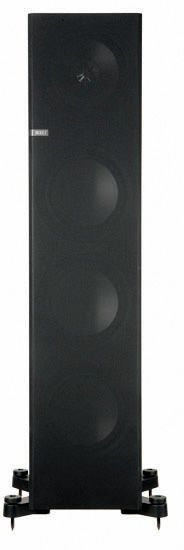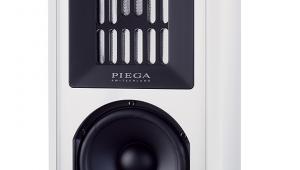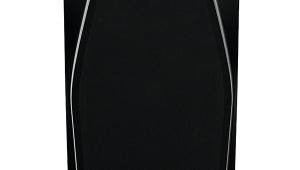Kef Q900 (£1200)
 The Q900 may be top of KEF’s brand, spanking new Q series – the meat and potatoes of its range – but to look at, inside and out, it appears in some ways to represent a step backwards, certainly in respect of KEF’s rich technological history.
The Q900 may be top of KEF’s brand, spanking new Q series – the meat and potatoes of its range – but to look at, inside and out, it appears in some ways to represent a step backwards, certainly in respect of KEF’s rich technological history.
The Q900 effectively replaces the previous iQ90, a speaker which bowled me over when winning a group test just over a year ago [HFN Mar ’10]. One of the notable aspects of the iQ90 was its curved cabinet, a feature of more than aesthetic significance since it stiffens the enclosure, whereas the large side panels of a conventional box cabinet are prone to resonance. It was a surprise, then, to find the Q900 has what KEF rather grandly terms a ‘rectilinear’ cabinet – what you and I would call a standard, slab-sided box.
KEF’s justification for this is that it liberates 30% extra cabinet internal volume, which can be exploited as higher sensitivity, greater bass extension or a mix of the two. Whether the trading-off of cabinet stiffness rates as a good idea is a moot point – particularly as our measurements show the Q900 to be 1.6dB less sensitive than the iQ90 (although both are specified at 91dB) and to gain a mere 3Hz in bass extension. Moreover, the knuckle-wrap test suggests that the cabinet is pretty lively – although there’s no evidence of telltale wrinkles in the impedance modulus or phase versus frequency curves that would indicate resonance problems.
Although the iQ90 did not incorporate KEF’s conjugate load matching technology (CLM) – and certainly didn’t merit its optimistic 8ohms nominal impedance – it was nonetheless still quite easy to drive, with a minimum modulus of 3.5ohm and a minimum EPDR (a measure of how much peak power is dissipated in the amplifier output devices) of 2.1ohm.
Equivalent figures for the Q900 are 3.0ohm and 1.5ohm, so it presents a more difficult load to the amplifier, despite its lowered sensitivity – and despite still being rated at 8ohms nominal. To be fair, many other speakers are moving in this same direction and in the Q900’s case it may have something to do with KEF’s championing of simpler crossover networks in the new Q series (another break with Maidstone’s past), which may have benefits for sound quality. Still, it’s somewhat out of keeping given that, when it introduced CLM, KEF made such a concerted effort to render its speakers easier to drive.
Like the iQ90, the Q900 is reflex loaded in the bass but you’ll search in vain for the ‘bitten biscuit’ reflex ports that have become a KEF hallmark. That’s because they are replaced with twin auxiliary bass radiators (ABRs) instead: effectively drive units minus motors. They are the two diaphragms above and below the central bass driver, which is rolled in to assist the Uni-Q array at low frequencies.
ABRs are a good thing in that their cones block off the internal air resonances that can all too easily express themselves via an open reflex port. But they again stir memories of KEF’s past. In fact KEF was one of the first manufacturers ever to exploit ABRs when it developed a motor-less version of its famous B139 sandwich-coned bass driver, the BD139. It was first used in the Cadenza of 1970 but is probably best remembered for its fitment in the famous Reference 104 and its 104aB successor a few years later [see also HFN Feb ’11].
A FEW INNOVATIONS
If I’m now sounding like an old fogey, it’s time to acknowledge that the Q900 also sports some new features. The most important of these can be found in the revised Uni-Q array. Nothing has changed, in that it still comprises a dome tweeter at the apex of a cone driver (where the dust cap would conventionally be), but much has been evolved. The cone is now of aluminium rather than plastic, which bodes well for freedom from the insidious viscoelastic effects that some attribute to thermoplastic cone materials.
Also new is the larger, 25mm diameter tweeter dome and the novel Z-flex cone surround. The latter is much flatter than a conventional half-roll surround, with radial pleats to permit sufficient excursion capability, and gives a more favourable acoustic termination to the tweeter horn that’s formed by the cone. The benefit of this is manifest in the much smoother upper treble output of the Q900, whose frequency response in the last octave is no longer the Uni-Q switchback of old.
One further change: we have become used in recent years to KEFs being supplied with linking cables rather than straps for their split crossovers, on the basis that these sound better. But the Q900 has neither cables nor straps, replacing them with screw-out links between the two pairs of input terminals. When these are screwed in fully, the terminals are linked for single-wiring; when screwed out fully, the two halves of the crossover are isolated for bi-wiring or bi-amping.
IS THAT A MELLOTRON?
I used the Q900s single-wired throughout the listening, driven by the same Exposure XVIII Monos I used for the iQ90 group test. Source files were played from a Mac mini running Windows XP and J River Media Centre, feeding an Arcam rDAC via its asynchronous mode USB input. Cables were Chord Chameleon Plus and Townshend Isolda.
Audio memory is notoriously volatile but, thinking back to that group test which included the iQ90s, I distinctly recall being knocked out by how well they’d delivered Mozart’s vivacious March K189, played by the Scottish CO [Linn CKD 287]. Recorded in Greyfriars Kirk, Edinburgh, this serves up a big, spacious acoustic but escapes being smothered in a blanket of clouding reverberation. Far from it: it has the sort of vibrant sound that over the wrong speakers can sear your ears. The iQ90s had turned the rare trick of recreating the cavernous acoustic while also giving full vent to the crispness and vitality of string playing that makes this track fizz with energy. On that basis, what better music to play through the Q900s as well?
The result was not a reprise of the iQ90 experience. The Q900 delivered on the large acoustic but was lacking the clarity and dynamic zeal to do full justice to the orchestral sound. There was also a slight edge to the strings – due, perhaps, to the Q900’s slight presence band emphasis – although I might have forgiven that had the sheer joie de vivre of this piece been more convincingly conveyed.
I had never owned a Uriah Heep LP but my contemporaries did, so I belatedly added the remastered Very ’eavy, Very ’umble [Sanctuary Records] to my CD collection recently, while the Q900s were in residence. ‘Come Away Melinda’’s lyrics may sound naive to modern ears – as they probably did to adult ones when freshly minted – but the token ballad from the original release is a good vehicle for David Byron’s fine voice and some atmospheric string sounds from Ken Hensley’s Mellotron.
INSIGHT MISSING
Wherein hangs a tale that I think encapsulates the Q900’s character of music-making. Not having played the track before, I reacquainted myself with it first through the Q900s. It sounded smooth, and warm and spacious, but I was pretty certain that the master-tape must be a leap or two removed, so I brought in a pair of Thiel CS1.6s for comparison.
As soon as the string sound began in the left channel my brain registered ‘Ah, a Mellotron’ – and I instantly realised that I hadn’t had that same reaction with these Q900s. Of course, when I went back to them that distinctive string sound was there to be heard, but first time around it just hadn’t struck me. Some hi-fi products readily convey this sort of insight, others don’t. The Q900s are in the latter category. Surmising that something lushly orchestral might suit the Q900s better, I next tried Rimsky Korsakov’s Scheherazade – the old Ansermet recording [Decca]. Ansermet’s tempi give the piece ample dash, and of course this recording is wonderfully big sounding in all respects.
Indeed, the Q900 was more in its comfort zone here. The brass blast that opens ‘The Sea and Sinbad’s Ship’ emerged from deep in a large acoustic space, pinning back your ears before the quiet solo violin enticed with its first seductive refrain. OK, I’m used to hearing a bit more precision and ‘you are there’ palpability to the sound, but the Q900 did make a creditable job of conveying the large dynamic range, as well as the spacious acoustic of Geneva’s Victoria Hall.
VERDICT
Without pushing the retrospection too far, the Q900 is a very different sounding speaker from the discontinued iQ90. If you liked and admired the latter, then the Q900 may disappoint. It has a less informative, less explicit nature than its forebear and won’t best suit listeners for whom insight and rhythmical dexterity are everything. But if you prefer a softer, less energetic sound, the high value Q900 may appeal.
Originally published in the April 2011 issue

























































